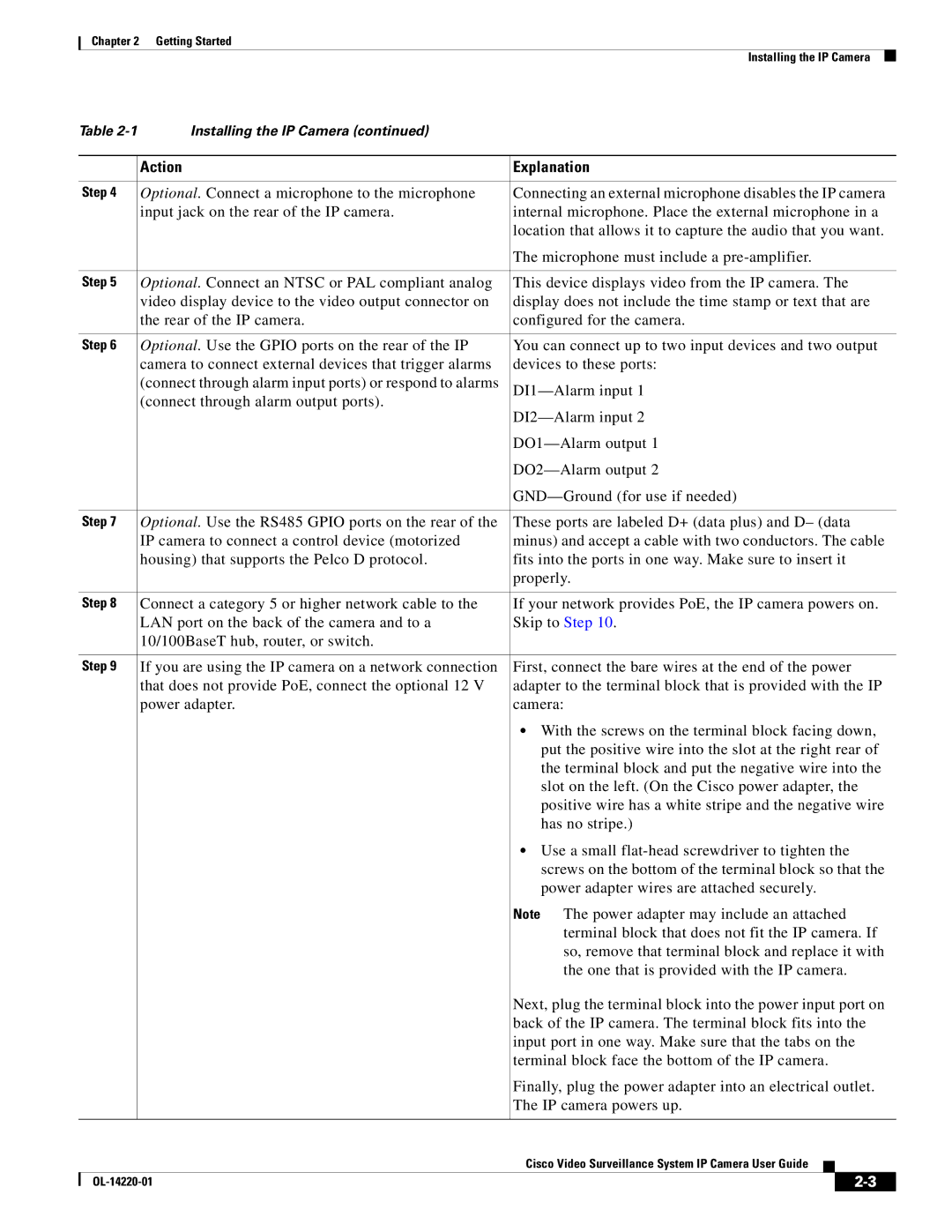Chapter 2 Getting Started
Installing the IP Camera
Table | Installing the IP Camera (continued) |
|
|
|
| |
|
|
|
| |||
|
| Action | Explanation | |||
|
|
|
| |||
| Step 4 | Optional. Connect a microphone to the microphone | Connecting an external microphone disables the IP camera | |||
|
| input jack on the rear of the IP camera. | internal microphone. Place the external microphone in a | |||
|
|
| location that allows it to capture the audio that you want. | |||
|
|
| The microphone must include a | |||
|
|
|
| |||
| Step 5 | Optional. Connect an NTSC or PAL compliant analog | This device displays video from the IP camera. The | |||
|
| video display device to the video output connector on | display does not include the time stamp or text that are | |||
|
| the rear of the IP camera. | configured for the camera. | |||
|
|
|
| |||
| Step 6 | Optional. Use the GPIO ports on the rear of the IP | You can connect up to two input devices and two output | |||
|
| camera to connect external devices that trigger alarms | devices to these ports: | |||
|
| (connect through alarm input ports) or respond to alarms | ||||
|
| (connect through alarm output ports). | ||||
|
|
| ||||
|
|
| ||||
|
|
| ||||
|
|
| ||||
|
|
|
| |||
| Step 7 | Optional. Use the RS485 GPIO ports on the rear of the | These ports are labeled D+ (data plus) and D– (data | |||
|
| IP camera to connect a control device (motorized | minus) and accept a cable with two conductors. The cable | |||
|
| housing) that supports the Pelco D protocol. | fits into the ports in one way. Make sure to insert it | |||
|
|
| properly. | |||
|
|
|
| |||
| Step 8 | Connect a category 5 or higher network cable to the | If your network provides PoE, the IP camera powers on. | |||
|
| LAN port on the back of the camera and to a | Skip to Step 10. | |||
|
| 10/100BaseT hub, router, or switch. |
|
|
|
|
|
|
|
| |||
| Step 9 | If you are using the IP camera on a network connection | First, connect the bare wires at the end of the power | |||
|
| that does not provide PoE, connect the optional 12 V | adapter to the terminal block that is provided with the IP | |||
|
| power adapter. | camera: | |||
|
|
| • With the screws on the terminal block facing down, | |||
|
|
| put the positive wire into the slot at the right rear of | |||
|
|
| the terminal block and put the negative wire into the | |||
|
|
| slot on the left. (On the Cisco power adapter, the | |||
|
|
| positive wire has a white stripe and the negative wire | |||
|
|
| has no stripe.) | |||
|
|
| • Use a small | |||
|
|
| screws on the bottom of the terminal block so that the | |||
|
|
| power adapter wires are attached securely. | |||
|
|
| Note The power adapter may include an attached | |||
|
|
| terminal block that does not fit the IP camera. If | |||
|
|
| so, remove that terminal block and replace it with | |||
|
|
| the one that is provided with the IP camera. | |||
|
|
| Next, plug the terminal block into the power input port on | |||
|
|
| back of the IP camera. The terminal block fits into the | |||
|
|
| input port in one way. Make sure that the tabs on the | |||
|
|
| terminal block face the bottom of the IP camera. | |||
|
|
| Finally, plug the power adapter into an electrical outlet. | |||
|
|
| The IP camera powers up. | |||
|
|
|
|
|
| |
|
|
| Cisco Video Surveillance System IP Camera User Guide |
|
| |
|
|
|
| |||
|
|
|
|
|
|
|
|
|
|
| |||
|
|
|
| |||
